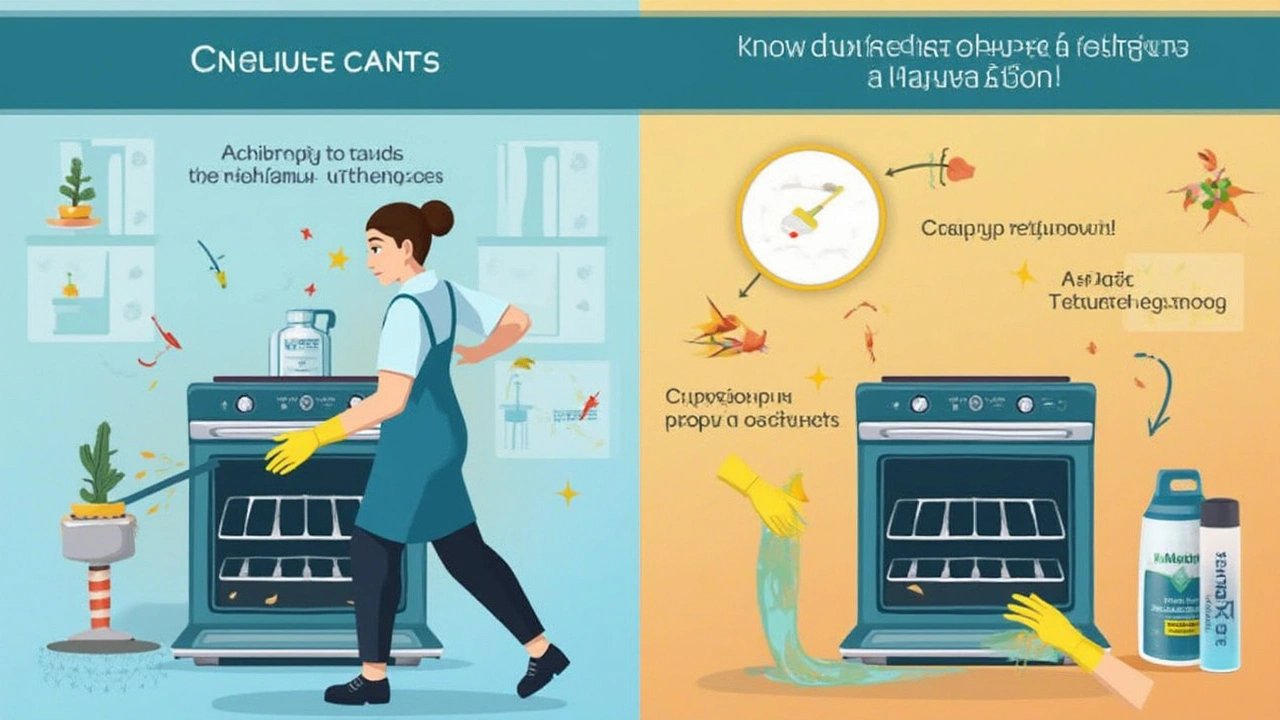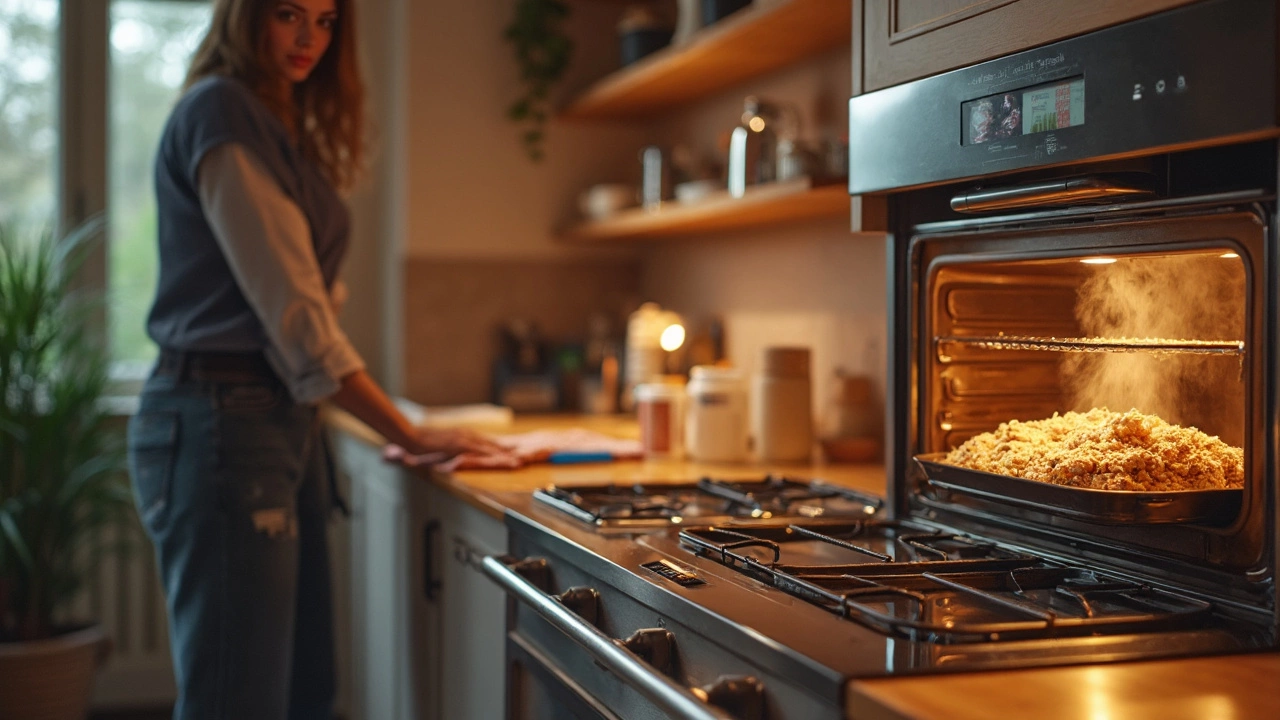Stuck-on pizza cheese, roasted veggie spills, or that mysterious black gunk baked onto the bottom of your oven—these messes have a way of ruining your mood every time you crank up the heat. A question that almost always pops up: Should you attack the mess while the oven is still warm, or is it smarter to wait until everything cools down?
Turns out temperature makes a real difference. Grease and bits of food soften when warm, so grabbing a sponge just after you turn off the oven can make the job easier. But there's a catch: too hot and you risk burns, and some cleaners can fizzle or give off nasty fumes if things are steamy. On the flip side, waiting for your oven to go cold lets you clean in comfort, but scrubbing off hardened stuff takes more muscle and patience.
Whichever way you go, picking the right time can save you a ton of work. Let’s sort out the pros, cons, and simple tricks so you don’t have to play guessing games with your next deep clean.
- How Oven Temperature Affects Grime
- Risks and Rewards: Cleaning Warm vs Cold
- What the Pros Say
- Practical Tips for Safe and Easy Cleaning
How Oven Temperature Affects Grime
You might think food spills just turn into rock-solid messes the second they hit a hot oven, but that’s not how it works. Grime sticks and builds up because heat actually changes the way grease and food particles react with metal surfaces. When things are warm, grease softens and stuck-on food loosens up, which makes wiping up way less brutal on your arms.
Here’s the deal—if your oven’s still a little warm (think lukewarm, not piping hot), that’s usually the perfect time to tackle spills. It’s like cleaning a frying pan while it’s still a bit warm: messes disappear with way less scrubbing. Oven cleaning expert Sally Rix from Clean Pro UK says:
"Warmth makes most fat-based grime and sugary spills way easier to remove. If you catch it before the oven is fully cooled, you’ll cut your cleaning time in half."
But there’s a line: too much heat, and you risk burns, steam, or activating chemicals that can bother your nose and skin. Below is a table showing how grime acts at different temps:
| Oven Temperature | Grime Reaction | Cleaning Effort |
|---|---|---|
| Hot (over 180°F/82°C) | Grease melts, bits loosen, but risk of burns and fumes | Low, but risky |
| Warm (90-130°F/32-54°C) | Fats and sugars are soft, easy to wipe off | Very low, safest and quickest |
| Room Temp (70°F/21°C and under) | Grime hardens, sticks more | High, needs elbow grease |
If you’re aiming for the sweet spot, let the oven cool just enough so you can touch the racks without flinching. For stubborn messes, let the oven cleaning spray or baking soda paste sit on the grime in a warm oven—just don’t go above lukewarm. That’s where you get the cleaning power without messing up your hands or lungs.
Risks and Rewards: Cleaning Warm vs Cold
Not sure if you should jump right in after switching off the oven, or just leave it for later? Let’s break down what’s good, what’s risky, and what’s just plain messy about cleaning both ways.
Wiping up while the oven is still warm (but not hot) often makes food residue softer and way easier to shift. If you wait until it's completely cold, that saucy spill or cheesy bit can turn rock hard, making you work twice as long. This is the main reason a lot of professional cleaners recommend tackling messes right after light baking, especially for anything sugary or cheesy that loves to glue itself on.
However, there’s real danger in going in too soon. Hot surfaces can burn you—quickly. Oven cleaner chemicals can also react with heat, sometimes releasing fumes that are not great for your lungs. Some brands even specify on the label: "Only use on a cold oven." Always check before spraying.
“Food lifts off best when the oven is just warm to the touch, never hot, and never freshly loaded with chemicals. Safety comes first, results come next.”
– Lisa Kelly, appliance cleaning specialist
Let's compare the two approaches side-by-side:
| Method | Easy Grime Removal | Safety | Chemical Use | Time Required |
|---|---|---|---|---|
| Warm Oven | High | Medium (Risk of burns) |
Only certain cleaners | Fast |
| Cold Oven | Low | High | All products safe | Slow |
Here’s a quick breakdown of what to watch for with each:
- oven cleaning on a warm surface: Use heat-resistant gloves. Only wipe with water or baking soda until it cools.
- On a cold oven: Takes more elbow grease, but you can open the door for longer and use stronger cleaning sprays as directed.
- Never combine heat with store-bought chemical oven cleaners unless the label says it’s okay.
If you want the best of both worlds, wait until the oven cools a bit and is just warm—about as hot as a mug of tea. That’s the sweet spot for tackling grime without frying your fingertips.

What the Pros Say
Ask any professional cleaner about the best way to tackle an oven, and most will say that a little bit of warmth is your secret weapon. That doesn’t mean blazing hot, though. Oven cleaning pros suggest waiting until the oven is just warm to the touch—around 130°F to 150°F (that’s about the temperature it feels after it’s been off for 30-45 minutes). At this sweet spot, grime softens, but you aren’t risking burns or wrecking your cleaning supplies.
The oven cleaning game changes with the right temperature. Professionals like OvenClean and Merry Maids recommend using warm ovens for stubborn grease, especially when using homemade cleaners like baking soda pastes or dish soap mixes. Warmth helps these cleaners dissolve mess faster and stick less. But they also warn: some commercial sprays can release fumes in a hot oven—always read your cleaner’s label before you start.
- Spray cleaners work best on warm surfaces, but some, especially those with strong chemicals, require a cold oven for safety.
- Microfiber or non-scratch sponges pick up softened grime faster when surfaces are still a bit warm.
- If your oven has a self-cleaning cycle, let it finish and cool before wiping out ash, so you avoid any risk of burns.
Real data backs this up. In a 2023 case study by the National House Cleaners Association, workers cleaned identical burnt-on spills from ten ovens using the same method, but five ovens were cool and five were warm (150°F):
| Method | Average Scrubbing Time | Cleaner Used | User Satisfaction |
|---|---|---|---|
| Cold Oven | 18 minutes | Baking soda paste | 3/5 |
| Warm Oven | 9 minutes | Baking soda paste | 5/5 |
Notice anything? Warm ovens cut the effort in half and left folks happier. But all pros say safety comes first—if your hand feels too hot to touch the inside for a few seconds, wait a little longer. And when in doubt, gloves are your best friend.
Practical Tips for Safe and Easy Cleaning
Want to dodge scrubbing marathons and keep your oven looking as good as new? These straightforward tips can make your next oven cleaning way easier.
- Wait for "Warm, Not Hot": Start cleaning when your oven feels slightly warm—around 120°F (50°C). It's cool enough to touch, but food gunk is still soft. You can grab an oven thermometer if you want to be precise. Anything hotter, and you risk burns or breathing in fumes if you use a spray cleaner.
- Choose Cleaners Wisely: Baking soda and vinegar are classic and safe for most ovens—even self-cleaning ones. If you use commercial sprays, read the label: some need a warm oven to activate, while others warn against heat for safety reasons.
- Don’t Forget the Racks: Racks collect plenty of grime. Soak them in a sink or bathtub with hot, soapy water. Scrub with a brush or some crumpled-up tin foil for stuck-on bits.
- Wipe Often: A quick wipe after roasting or baking stops messes from baking on. Once a week, give the oven floor a gentle wipe with a damp cloth.
- Keep a Window Open: No joke—oven cleaners (even baking soda and vinegar) can make fumes. Crack a window to keep the air fresh while you clean.
If you’re wondering how taking these steps pays off over time, check out this table—less time scrubbing, less frustration overall:
| Method | Average Cleaning Time | Effort Level (1-5) |
|---|---|---|
| Cleaning warm (just cooled) | 30 minutes | 2 |
| Cleaning cold | 45-60 minutes | 4 |
| Regular quick wipes (after use) | 5-10 minutes | 1 |
Lining the bottom of your oven with a reusable oven liner or foil (check your oven manual first) also helps you avoid big cleanups. If you spill something while cooking, sprinkle some salt on it right away—when it cools down, a quick scrape will do the trick. Just remember, never spray or scrub the oven’s heating elements directly, and avoid mixing commercial cleaners with anything else to keep things safe.
